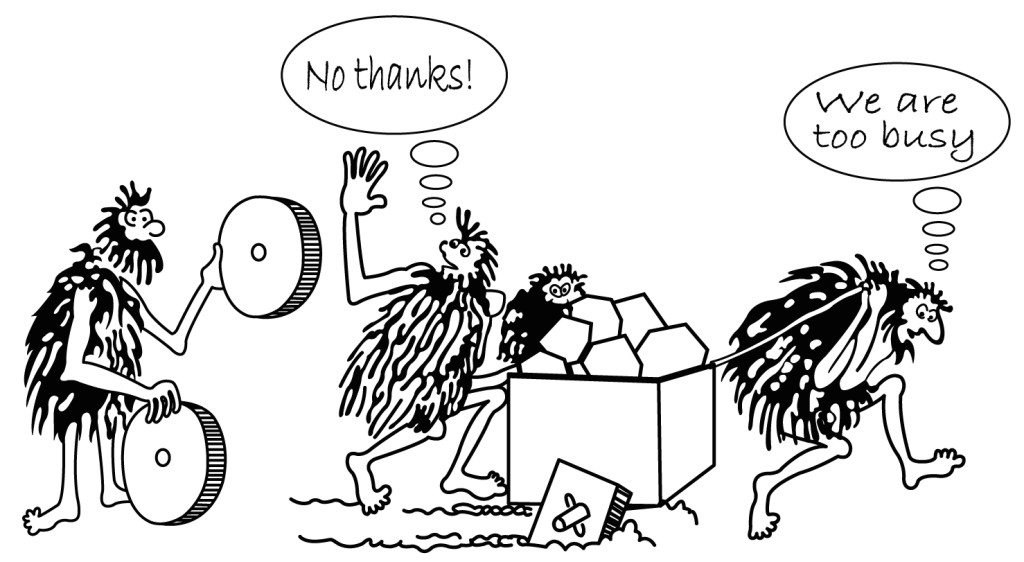Are Your People Frantic?
Do you sense a frantic pace where you work, in that people are always in a hurry? Frenetic? Anxious?
And when you try to meet with someone, is their calendar full for the next two weeks?
And when you say, “I have an idea for how to improve something – can we talk?” is their response something like, “After this current delivery period – there will be more time then”?
If so, then your organization is operating in a constant fight-or-flight crisis mode. And people are burning themselves out.
And they have no time for continuous improvement.
So don’t be surprised if you tell them to think for themselves, and to take responsibility for improving things, but it seems to fall on deaf ears. It’s because they are simply too busy! Too overloaded. Too worried about the current deadline. They simply do not have the emotional, cognitive, and time capacity to consider anything except what is right in front of them, and be laser focused on the current deadline.
It’s the classic case of “too busy to improve” – something that the Agile community has talked about from the beginning of the Agile movement.
But Other Companies Do It
We all hear about companies that continuously improve. We ourselves have written about such companies – companies like SpaceX, Spotify, and Netflix. How do they do it? And if they can, why can’t we?
You can, but you need to understand the human dynamics.
People have a finite capacity every day, every week, every month, and every year. That capacity has many components. One is cognitive: how much they can think about – issues running in the back of their mind, sometimes coming to the forefront to get solved.
Another component is emotional: how many things can they care about at once? Imagine there is a house burning down, and you are wearing protective clothing and so you can rescue them, one by one. But there are 100 people in the house. Can you worry about all of them? No - you focus on a few at a time.
Yet another component is simply hours in the day.
People normally give part of their overall capacity to work, and reserve the rest for their “life” – their family, their world outside of work.
If you create an existential threat, then people will also contribute their personal reserve to addressing that threat. For example, during a war, people tend to not differentiate between work and home – they are trying to survive the war.
Similarly, if work is so inspiring that it becomes existential to them, they will also contribute their private life capacity to the work. SpaceX taps into that: the salaried employees at SpaceX all view SpaceX’s mission as a personal dream of their own. It is their life. In the same way, in organizations that have missions to help others, many employees view the mission personally.
But few organizations have such inspiring missions. In most organizations, people will – and should – reserve part of their capacity for “life”, not “work”.
That means that if their normal day is completely consumed by just keeping their head above water, they will have no capacity – no emotional, cognitive, or time capacity – to consider anything except what is right in front of them.
They will not pay much, if any, attention to how to improve things.
What To Do
If your organization does not need to continuously improve, there is no problem. But if you have aggressive competitors, and technology is constantly changing the landscape on which you operate, then you absolutely need people to be focused on improvement. Otherwise, you will become obsolete: you will become a victim of the innovator’s dilemma.
Here’s the thing about companies like SpaceX: they always have brilliant innovative leaders. But those leaders are not bottlenecks.
Consider SpaceX. Elon Musk sets direction, and he pays attention to issues. He does not operate from a distance. But – and this is the important part – he challenges people to solve problems. He doesn’t tell them how to solve those problems. He gives them space to be creative. He expects it. And he never sets hard deadlines. All of SpaceX’s deadlines are aspirational. They have no delivery schedules. The things they measure and focus on are the key metrics that they have identified as being between them and their goals.
To SpaceX, advancing toward the goal eclipses delivery. They prioritize the mission over the task.
Thus, the key is to be thoughtful about what you focus on, and what you measure. If you are obsessively focused on output and schedules, that is what you will get. But you will lose the continuous self-improvement that people are capable of.
Instead, consider asking people what they think is between your current situation and your goals. Participate in that discussion. And then consider giving people problems to solve, like “How can we achieve that? And how can we move quickly in that direction? What are the milestones along the way? And what are the key metrics that will reveal actual progress?” – progress that is about outcomes, not deliverables or performance theater.
In a post today in LinkedIn, one person wrote,
“the most successful agile organizations I've worked in, not as a coach, we'd asked one simple question - is what we are doing agile?”
There are two things that stand out in his comment:
In the above context, he was not a coach. So I presume he was someone with accountability for results. That's important.
He (and his peers) began by asking a question. That's important too.
Without those two ingredients, there will be no improvement.
One final thing I would like to share. I am currently reading Walter Isaacson’s book about Elon Musk. This passage on page 101 stood out:
“He [Musk] focused on one key metric: what it cost to get each pound of payload into orbit.”
This is a key aspect of how SpaceX works: they analyze their situation and identify the constraint that is holding them back, and then they focus on that. And that approach applies not only at the company level, but at every level – for everything people work on: every problem they are trying to solve.
They are not output-focused: they are outcome-focused, and constraint-focused.






